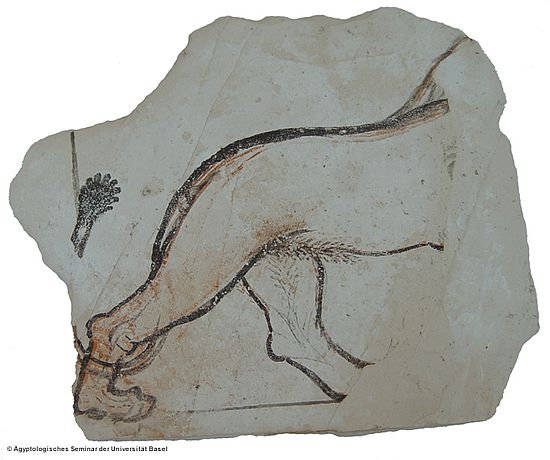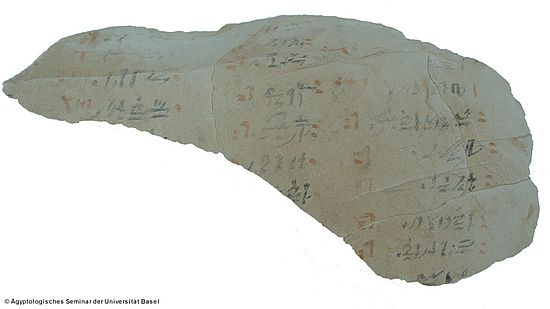Workers' huts in the Valley of the Kings
In the Valley of the Kings there are not only traces of those who were buried there, but also of those who made their burial possible: the workers, craftsmen or artists who had hewn out and decorated the tombs. The knowledge of their traces in the Valley of the Kings was so far small and accordingly little noticed - these traces lay, so to speak, in the shadow of Deir el-Medine (Fig. 1), the village southeast of the Valley of the Kings, where the mentioned craftsmen lived with their families.
With our excavation of the area around KV 47 (Siptah) and KV 18 (Ramses X.) the knowledge about the presence of the workers in the Valley of the Kings itself has increased considerably.
First, there were "construction barracks" in the immediate vicinity of the tombs under construction. To this type belong the so far known remains near the junction of the routes to KV 47 (Siptah) on the one hand and to KV 32 (Tiaa) and 34 (Thutmosis III) on the other hand as well as the structures newly discovered by our mission opposite the entrance of the tomb of Siptah (KV 47). The evaluation of these features including ostraca and small finds is still pending.
On the other hand, in the vicinity of the tomb of Rameses X. (KV 18) an accumulation of workers' huts, which go far beyond the type "building barracks", since it is an accumulation of more than twenty-five coherent rooms, and already rather resemble a mini-settlement à la Deir el-Medine. It is fair to say that this find is sensational. This cluster of workers' huts southeast of KV 18 will be discussed below.
The workers' huts near KV 18
After the work in the tomb of Ramses X was finished, the excavation in the surroundings of this tomb KV 18 was continued. Today's excavation policy is rightly that, according to which investigations should not be limited to the tombs and the surrounding entrance area. Since the time of the construction of the tombs and up to the present time, a lot of material has been moved in the Valley of the Kings: ancient excavated material as well as rubble, which has been moved here and there by various excavators. The entire area of the Valley of the Kings was originally located at a much lower level, and the landscape would have a somewhat different impression if this "waste debris" were consistently removed. So the area was excavated down to the bedrock and the sifted material was hauled out of the valley on the trailer of a tractor.
During the 2000/2001 campaign, a cluster of rooms was discovered in the small wadi (desert valley) extending southward to the east of KV 18 (Ramses X.) and KV 54 (the so-called embalming cache of Tutankhamun). Workers' huts in the Valley of the Kings are not new - remains have been found elsewhere - but what is new is the extent and the situational coherence.
A sensational find - unexpected, revealing. The newly discovered traces of craftsmen in the Valley of the Kings, with numerous finds indicating a wide range of activities, help to provide further insight into the everyday life of workers and the administration associated with the construction of royal tombs.
Team MISR
Description
Directly to the finds.
The settlement today consists of three isolated groups of huts. The first of these is located in the very south of the small wadi that lies to the east of the tomb of Ramesses X. Along the eastern flank of the wadi, the huts of this group extend far to the north. The back walls of these rooms have been carved out of the in-situ rock. A second group of three huts is located northwest of the first group, directly on the opposite flank of the terrain that slopes less steeply here, and the third group is located a little farther north directly above the tomb of Ramesses X, which had not yet existed at the time the huts were built. Originally, all of these huts belonged to a single contiguous settlement that had encompassed the entire wadi east of the Tomb of Ramses X and also occupied the open area between the huts to the east and west of the wadi. Today, this area contains only the rubble from previous excavations. A total of 25 rooms are still preserved from the settlement, remains of another ten could be found, and the existence of at least 14 other huts can be deduced from the data on already published hieratic ostraca that come from this area. These ostraca were excavated in 1907/08 by Edward Ayrton for Theodore M. Davis. If one imagines the present debris area also built upon, one may assume a settlement with at least 60-80 huts.The individual rooms are mostly relatively small. They measure about 2 m x 2 - 2,5 m. The walls are built of unworked stones as dry stone walls and are preserved from one stone layer up to a height of 60 cm and rarely even a little higher. No remains of roofs or covers of the rooms have survived. Instead, one may imagine palm fronds or straw mats laid over thicker branches and weighted down with stones. The floors consist of a compact mixture of sand and fine limestone fragments, sometimes with additions of ash or Nile mud. Fireplaces were found in some of the rooms.
The finds from the rooms consist of hieroglyphic, hieratic and pictorial ostraca, of pottery, mostly plates and strikingly less closed forms and in two cases of larger vessels buried in the ground, of cast models and some other objects. Fish bones, apart from the supply of grain, give a limited insight into the food consumed by the workers.
Numerous objects found in different rooms allow dating the preserved huts to the reign of Ramesses IV. These are two ostraca with the complete titulature of the king, a sculpture exercise showing the goddess Isis worshipping the name of Ramses IV's "Strong Bull", anch-em-maat, "The One Who Lives by the Maat", and, above all, an ostracon listing workers on the right side of the team and the grain distributed to them. The sequence of names corresponds, except for two deviations, to those of the lists of watch-keepers from the second year of the reign of Rameses IV, with the addition of the names of the foreman of the team Nachemmut, his deputy Amunchau, the scribe Amunnacht, and other workers who were not watch-keepers. The dating of the huts to the period from the second year of the reign is additionally supported by numerous personal names of workers and their sons mentioned on stelae as well as by the throne name of Ramesses IV, which is exclusively documented in the workers' huts. Heqa-Maat-Ra setep-en- Imen, which he adopted from the end of his first year of reign instead of Wsr-Maat-Ra stp.n Jmn. The huts in the rear part of the wadi seem to have been abandoned at the end of the reign of Ramesses IV or a little later, since no finds from the time of his successors were made in them. This results in a period of use of about 5-7 years for these huts.
The extensive hut settlement from the time of Ramses IV leads to a new appearance of the Valley of the Kings: The landscape is no longer characterized only by rocky cliffs and slopes in which burial passages were made, and by rubble mounds deposited in various places, consisting of rocks from inside the tombs, but also by huts built directly next to each other, which covered a considerable area. The Valley of the Kings was not only a sacred place, the last secluded burial place of the kings of the New Kingdom, but also a construction site and at the same time a temporary residence for the workers. The distance from the tomb, the size of the settlement, and the few administrative texts with a reference to construction activity at the tomb of Ramesses IV make it clear that the huts served as simple dwellings in which the workers lived during the nine-day work week. The tenth day was free of work.
As early as the late 18th and then the 19th Dynasties, evidence of workers' huts can be found in the Valley of the Kings. However, in contrast to the huts from the time of Ramses IV, these were located much closer to the king's tomb, which was under construction. The numerous ostraca from the end of the 19th Dynasty from the vicinity of the tombs of Sethos II (KV 15), Tausret (KV 14), Bay (KV 13) and Siptah (KV 47) originate from such a context. The best known earlier huts were located directly above the tomb entrance of Tutankhamun (KV 62). The function of the huts from the time before the 20th Dynasty - whether also as temporary living quarters or merely as simple shelters and magazines for tools, paints, lamps etc. - cannot be determined due to missing data. - cannot be determined due to the lack of information about the original circumstances of the find.
The largest surviving group of workers' huts in Thebes-West is located halfway along the highest point between Deir el-Medine and the Valley of the Kings. It is called station du col or station de repos and comprises 78 huts. The oldest written evidence from these huts, which can be dated with certainty, dates from the reign of Ramesses II, but they were still in use at the time of Ramesses IV, i.e. at the same time as the huts below in the Valley of the Kings. This is proven by finds of the same persons of the station de repos, as for example the fragmentary limestone seat of the scribe Amunnacht, son of Ipuy, and a stele of the same scribe from the workers' huts west of the tomb of Ramesses X. Against the background of persons attested at both sites, the relationship of the station de repos to the huts in the valley remains to be investigated in more detail: On the one hand, the station de repos itself certainly served as a control post, since access to the Valley of the Kings was only allowed to workers and a few high officials, and on the other hand, it served as a shelter, as numerous bed niches and neck rests make plausible. In contrast to those in the Valley of the Kings, the huts of the station de repos were more solidly built, and the walls were even partially plastered on the inside. This qualitative difference in construction may have been due to the location in a saddle exposed to the wind and probably also to the longer period of occupancy.
A neck support was also found in situ in the huts from the time of Ramses IV in the Valley of the Kings, which underlines the use of the huts as sleeping quarters. Furthermore, several "stelae" found in different rooms are worth mentioning, which, as with the station de repos, allow identification of the occupants of individual rooms. On one of these "steles" the adorant Pentaweret can be seen in front of the serpentine goddess Meresger, who enjoyed great veneration as the patron saint of the workers of Deir el-Medine. Thanks to the naming of the son Nebnefer behind Pentaweret's back, he can be identified without doubt with a worker known from other documents as well. Pentaweret is attested during the reign of Ramesses IV and possibly also during that of his successor, Ramesses V.
The "stelae" are an expression of the personal piety of the workers. They testify to the need to be able to make direct contact with a deity especially venerated by the worshipper, not only at home or in a sanctuary near Deir el-Medine, but at any time. The common origin of stelae, a few administrative texts and pictorial ostraca with quite different, but not religious motifs from the individual rooms excludes the identification of the rooms as small chapels. These find circumstances and especially the missing consecration inscriptions or vows make it clear that the "stelae" are not votives that were later to be donated to a sanctuary, but objects of private property belonging to the furnishing of a living space.
In addition to objects that illustrate the anchoring of religion in everyday life, literary texts such as copies of the teachings of Amunacht, of Papyrus Lansing, and of the satirical letter of Hori (Papyrus Anastasi I) also came from the huts and the ancient rubble mounds. All of these literary texts in the narrower sense, as well as most of the sample letters that can be counted as literary texts in the broader sense, can be clearly identified as texts by scribal students on the basis of their handwriting and scribal errors. Transcripts of the same texts or even directly adapting fragments were already found during the excavations of T. M. Davis in 1907/08. These texts make it clear that, in addition to work, apprentice scribes were trained, or that young scribes wrote down instructional pensa and practiced letter writing. It is striking that all of these texts are written in New Egyptian. This dated group of literary ostraka, subject to the specific site of discovery of the construction site/settlement in the Valley of the Kings, gives an indication that mainly New Egyptian texts were used in scribe training in the mid-20th Dynasty and that the classical Middle Egyptian texts were given less consideration in scribe training. This finding reflects in a simple way the linguistic realities of the time: both the written and spoken language was New Egyptian.
The pictorial ostraca from the workers' huts may have been produced by painters or even by simple laborers in their spare time analogous to the writing of texts by scribes or students. Many of the pictorial subjects as well as some of the texts show no relation to the Valley of the Kings or the royal tomb. If the location of the "Valley of the Kings" were not known for these objects, one would certainly assume Deir el-Medine as the place of origin for many an ostracon.
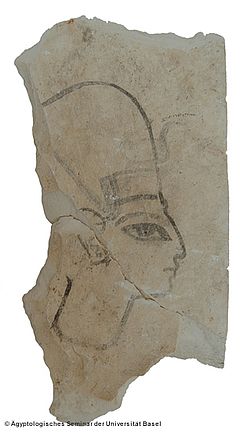
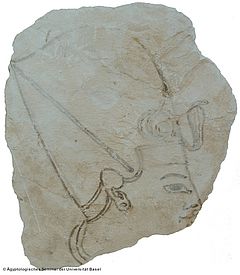
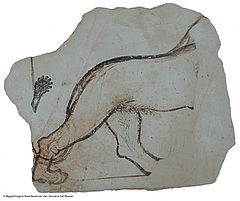
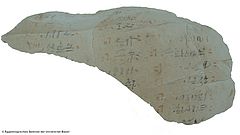
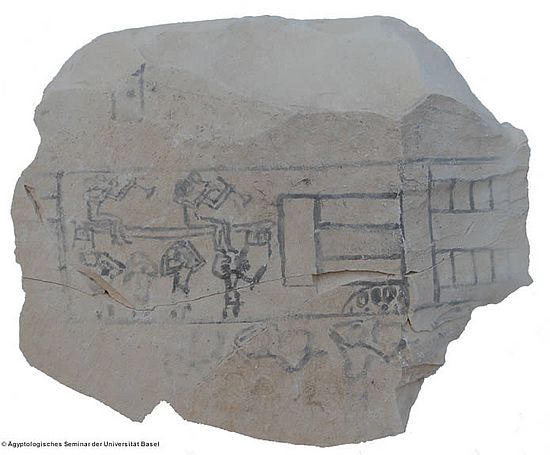
A highlight - today in the museum of the city of Luxor
Ostracon with a sketch of craftsmen during the construction of a royal tomb.
On the transverse axis, the staircase with ramp leading to the tomb entrance is shown on the right. This is followed by the door drawn folded down, and behind it on a long scaffold (just like Egyptian workers still use today!) sit two workers chiseling on the wall of the corridor. Below are four workers carrying away rubble in baskets, as well as the only faintly recognizable figures outside the tomb (below).

Publications on this topic
- Debora Cilli, The Late 19th Dynasty Ostraka from the Site of Pharaoh Siptah's Tomb (KV 47) in the Valley of the Kings, dissertation, Basel 2013 (in Italian).
- A. Dorn, Workers' Huts in the Valley of the Kings. A contribution to ancient Egyptian social history based on new source material from the mid-20th Dynasty (Aegyptiaca Helvetica [AH], vol. 23), 3 volumes, 1 CD-ROM, Basel: Schwabe 2012.
- A. Dorn, Leben auf der Baustelle - Funde aus Arbeiterhütten im Tal der Könige lassen den Alltag pharaonischer Handwerker nachvollziehen, in: Antike Welt [AW], vol. 38/1, 2007, 19-24.
- A. Dorn, Men at Work. Two ostraca from the Valley of the Kings with non-canonical depictions of workers, in: Mitteilungen des Deutschen Archäologischen Instituts. Cairo Department [MDAIK], vol. 61, 2005, 1-11.
Quick Links






